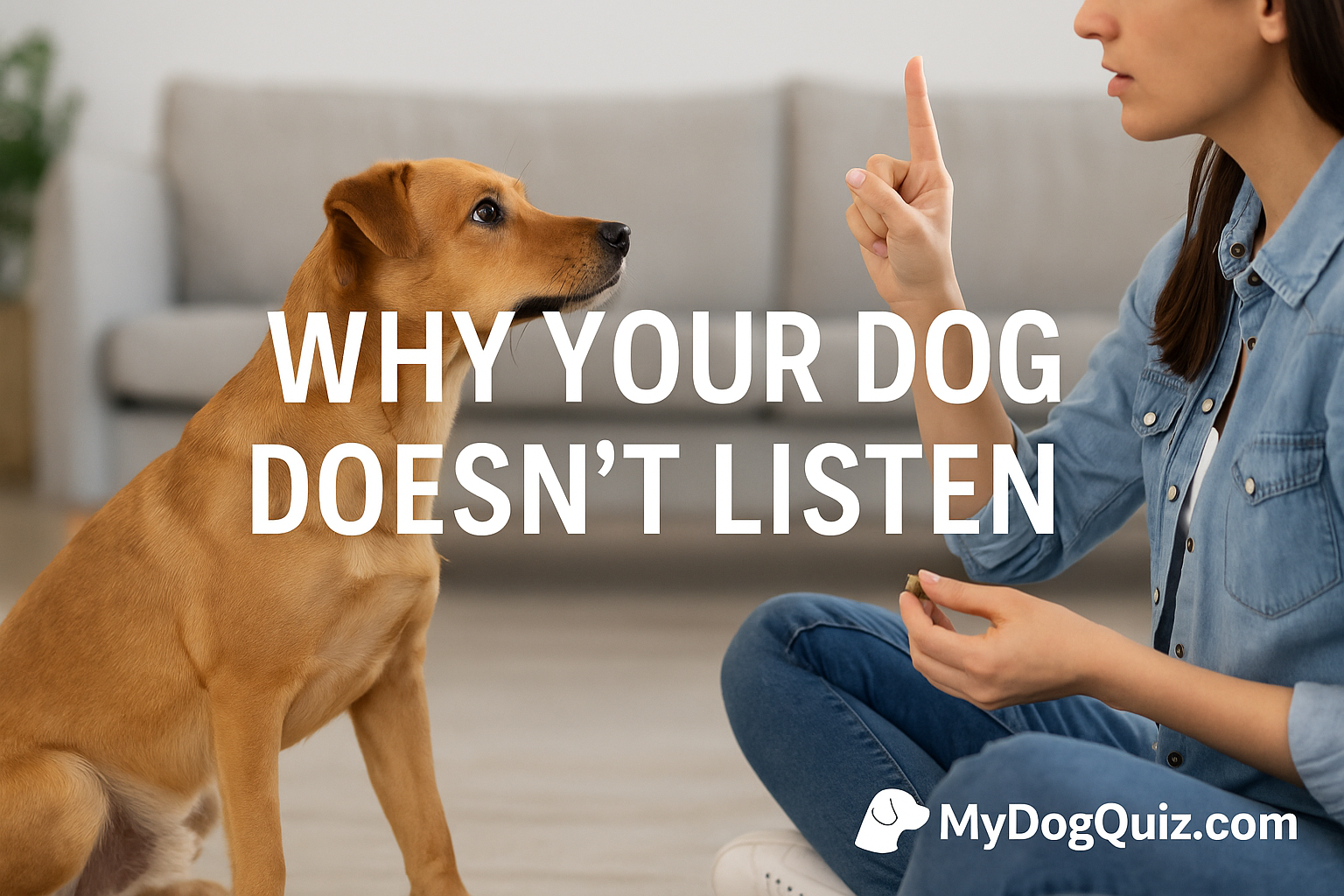You adore your dog. They’re your companion, your stress-reliever, your best friend. But sometimes, it feels like your best friend has selective hearing.
- You say “sit,” and they look at you blankly.
- You call “come,” and they sprint in the opposite direction.
- You’ve bought treats, watched videos, maybe even hired a trainer — yet your dog still acts like they’ve never heard a command in their life.
It’s frustrating. But here’s the truth most dog owners never hear:
Your dog isn’t ignoring you on purpose — their brain just learns differently.
Before you give up, take this quick step:
👉 Take the 30-Second Dog Brain Quiz to discover your dog’s unique learning style.
1. The Real Reason Dogs “Tune Out”
When dogs don’t listen, most people assume it’s defiance or bad behavior. But what’s really happening is a disconnect between how humans teach and how dogs process information.
Dogs don’t think in words — they think in patterns and associations.
Every time you speak, move, or even breathe differently, your dog’s brain is making micro-connections: “Does that sound mean treat time? Walk time? Or am I in trouble?”
If the signal keeps changing — tone, timing, or body language — your dog’s brain can’t map it to a clear command.
That’s why yelling louder or repeating yourself doesn’t help. To your dog, it’s just more noise.
2. What Most Owners Do Wrong (Without Realizing It)
Let’s look at a few common mistakes that cause obedience issues:
❌ Repeating Commands Too Often
Saying “sit, sit, sit!” teaches your dog that the word “sit” doesn’t really require immediate action.
Dogs respond better when the command is clear once, then followed by consistent feedback — praise when they get it right or redirection when they don’t.
❌ Mixing Body Language and Tone
If you say “stay” but lean toward your dog, your body is signaling “come.”
Dogs read movement more than words. Mixed cues confuse their brains.
❌ Training Only When There’s a Problem
We tend to train in the moment — when the barking starts, when the leash pulls, when the doorbell rings.
But dogs learn through routine and repetition, not frustration.
That’s why short, brain-based games work so well — they keep learning positive and frequent.
3. The Science of “Brain Training”
You’ve probably heard of physical exercise for dogs — walks, fetch, agility courses. But there’s another side of fitness just as important: mental exercise.
When your dog’s brain is challenged in the right way, it releases dopamine — the “happy focus” chemical that makes learning fun and rewarding.
A mentally stimulated dog is calmer, more obedient, and less likely to chew, bark, or misbehave.
Certified trainer Adrienne Farricelli built her Brain Training for Dogs program on this exact concept — teaching obedience by engaging the brain instead of punishing the body.
Her methods use short, playful exercises that unlock focus and confidence.
Once a dog’s brain “wakes up,” they start listening almost automatically.
👉 Curious what kind of learner your dog is?
Take the 30-Second Dog Brain Quiz and find out now.
4. Dogs Learn Like People — in Different Ways
Just like kids in a classroom, no two dogs learn exactly the same way.
Some are thinkers — they need a moment to process commands.
Others are doers — they learn through repetition and excitement.
And some are emotional learners — they tune in to your tone and mood more than anything else.
Once you know which type your dog is, training becomes so much easier.
Instead of fighting against their instincts, you work with them.
Imagine being able to:
- Calm your dog with one simple cue.
- Stop leash pulling without harsh corrections.
- Teach recall that actually works — even at the park.
That’s what happens when you train the brain first, not the behavior.
5. Why Traditional Training Often Fails
Most traditional training methods rely on physical repetition — say the command, correct the mistake, reward the success.
It works… until life gets distracting.
A dog’s brain doesn’t store “obedience” like a file on a computer.
It builds pathways through fun, repetition, and emotional engagement.
When those things disappear, the behavior falls apart.
That’s why dogs who ace obedience school sometimes forget everything a month later — their brain never truly connected the dots.
Brain-based training, on the other hand, taps into your dog’s problem-solving circuits.
It turns every command into a game, and every success into an instinct.
6. Real-World Example: Bailey’s Breakthrough
Mark loved his beagle, Bailey, but he dreaded when guests came over.
Bailey barked non-stop, jumped on everyone, and ignored every “quiet” command.
After a few failed training classes, Mark nearly gave up — until he tried one 5-minute brain game called “The Calm Freeze.”
Instead of yelling “stop barking,” Mark played a simple game that rewarded Bailey for eye contact and silence.
Within a week, Bailey learned that calm attention earned praise — and the barking vanished.
Mark didn’t change Bailey’s personality.
He simply activated her thinking brain instead of her reactive brain — and that made all the difference.
That’s the power behind Brain Training for Dogs — the same program built around the games Bailey used.
7. How to Re-Engage Your Dog’s Brain Today
You don’t need fancy tools or endless time.
You just need to make training mental, not mechanical.
Here are a few ideas you can try right now:
- The Cup Game: Hide a treat under one of three cups and let your dog find it. Builds focus and memory.
- Name the Toy: Use one toy’s name (“ball”) until your dog can fetch it by name. Strengthens communication.
- Hide and Seek: Call your dog from another room. Rewards recall and keeps training fun.
Even five minutes a day can rewire how your dog listens.
8. Ready to Understand Your Dog’s Mind?
If you’ve tried everything — treats, trainers, even YouTube tips — and your dog still doesn’t listen, it’s not your fault.
You’ve just been speaking the wrong language.
Your dog isn’t broken.
They just need you to engage their brain, not battle their instincts.
👉 Take the 30-Second Dog Brain Quiz to discover your dog’s learning personality and get custom training tips that actually work.
In under a minute, you’ll know why your dog behaves the way they do — and how to finally get them to listen, focus, and thrive.
Because when you train your dog’s brain, obedience isn’t forced… it’s fun.
🦴 Final Thoughts
Every great relationship starts with understanding.
Your dog doesn’t want to misbehave — they want to connect.
When you unlock how their brain learns, everything changes.
Less barking.
Better focus.
More peace at home.
Take the quiz, meet your dog’s inner genius, and start transforming frustration into fun — one brain game at a time.


Leave a Reply